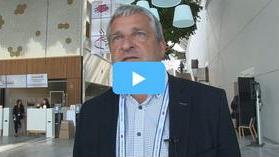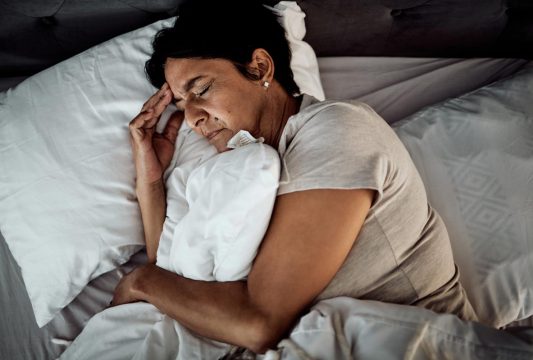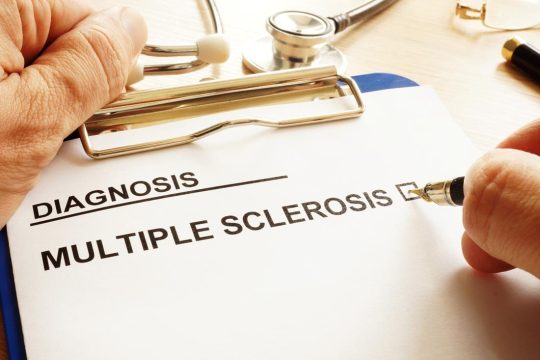Advertisment
EHA 2016: Preventing clonal evolution in multiple myeloma – evidence from clinical trials. Professor Roman Hájek from the Czech Republic discussed the clinical implications of clonal evolution in multiple myeloma (MM) and summarised the latest clinical data.

Preventing clonal evolution in multiple myeloma – evidence from clinical trials
by Maria Dalby
Professor Roman Hájek from the Czech Republic discussed the clinical implications of clonal evolution in multiple myeloma (MM) and summarised the latest clinical data. Professor Hájek reminded the audience that MM is a complex disease that as it progresses from monoclonal gammopathy of unknown significance (MGUS) via smouldering myeloma to active MM requiring treatment, the disease shows increasing genetic instability in the form of copy abnormalities, DNA hypomethylation and acquired mutations.1, 2 Several genetically distinct subclones are present at diagnosis;3-6 factors, such as treatment, cause these subclones to evolve over time and this clonal evolution can lead to disease progression and treatment resistance.3, 6, 7 Not only does clonal heterogeneity in MM look different at different stages of the disease,7 but it will also vary depending what site the bone marrow is collected from.8
The main clinical implications of clonal evolution in MM are that treatment should be initiated at an early stage of the disease where there is less genetic instability and fewer clones, and that both newly-diagnosed and relapsed MM should be treated with combination therapy with agents with different mechanisms of action.4, 6, 9 The place for targeted/personalised therapy and monotherapy should be eradicating residual disease, not the start of treatment.9 The results of randomised controlled trials (RCTs) show consistently that triplet therapy prolongs progression-free survival (PFS) compared with doublet therapy in patients with up to three prior lines of therapy10-16 and in newly-diagnosed patients.17-20 In particular the monoclonal antibodies elotuzumab and daratumumab have demonstrated impressive PFS benefits when added to lenalidomide plus dexamethasone13, 15 and bortezomib and dexamethasone,14, 21 respectively. A meta-analysis of five RCTs comparing triplet with doublet therapy that was presented at this year’s American Society Of Clinical Oncology (ASCO) annual meeting showed that the pooled odds ratios (OR) for triplets versus doublets were 2.325 for complete response (CR) or better (p<0.000); 1.962 for very good partial response (VGPR) or better (p<0.001); and 1.811 for the overall response rate (ORR; p<0.000). A pooled hazard ratio for PFS of 0.674 was found in favour of triplet therapy (95% CI 0.613, 0.741; p=0.000).22 As expected the risk ratio of overall and selected grade ≥3 adverse events was higher in the triplet arm.
Sequencing or alternating agents with different mechanisms of action may be an alternative to combination therapy in frail patients. A recently published phase 2 study in 233 patients aged over 65 years compared 9 cycles of of bortezomib, melphalan and prednisone (VMP) followed by 9 cycles of lenalidomide and dexamethasone (Rd; sequential use) with alternating administration of 1 cycle of VMP followed by 1 cycle of Rd for up to 18 cycles (alternating use). No significant differences were seen between the two arms in complete response rate (42% and 40%), median PFS rate (32 months vs 34 months), and 3-year overall survival (72% vs 74%), with similar haematological and non-haematological toxicity profiles.23 Another potential strategy is continuous therapy which has been shown to prolong the time to both first and second progression and overall survival in patients with newly-diagnosed MM.24 Professor Hájek concluded by stressing that understanding clonal evolution in MM is essential for selecting treatment strategies that can target coexisting subclones in a synergistic way and thus achieve a deeper response.
References
- Morgan GJ, Walker BA, Davies FE. The genetic architecture of multiple myeloma. Nat Rev Cancer 2012;12:335-48.
- Walker BA, Wardell CP, Melchor L, et al. Intraclonal heterogeneity is a critical early event in the development of myeloma and precedes the development of clinical symptoms. Leukemia 2014;28:384-90.
- Bahlis NJ. Darwinian evolution and tiding clones in multiple myeloma. Blood 2012;120:927-8.
- Keats JJ, Chesi M, Egan JB, et al. Clonal competition with alternating dominance in multiple myeloma. Blood 2012;120:1067-76.
- Bianchi G, Ghobrial IM. Biological and Clinical Implications of Clonal Heterogeneity and Clonal Evolution in Multiple Myeloma. Curr Cancer Ther Rev 2014;10:70-79.
- Bolli N, Avet-Loiseau H, Wedge DC, et al. Heterogeneity of genomic evolution and mutational profiles in multiple myeloma. Nat Commun 2014;5.
- Brioli A, Melchor L, Cavo M, et al. The impact of intra-clonal heterogeneity on the treatment of multiple myeloma. Br J Haematol 2014;165:441-54.
- Raab MS, Lehners N, Xu J, et al. Spatially divergent clonal evolution in multiple myeloma: overcoming resistance to BRAF inhibition. Blood 2016;127:2155-7.
- Mateos MV, Hernandez MT, Giraldo P, et al. Lenalidomide plus dexamethasone for high-risk smoldering multiple myeloma. N Engl J Med 2013;369:438-47.
- Garderet L, Iacobelli S, Moreau P, et al. Superiority of the triple combination of bortezomib-thalidomide-dexamethasone over the dual combination of thalidomide-dexamethasone in patients with multiple myeloma progressing or relapsing after autologous transplantation: the MMVAR/IFM 2005-04 Randomized Phase III Trial from the Chronic Leukemia Working Party of the European Group for Blood and Marrow Transplantation. J Clin Oncol 2012;30:2475-82.
- Stewart AK, Rajkumar SV, Dimopoulos MA, et al. Carfilzomib, lenalidomide, and dexamethasone for relapsed multiple myeloma. N Engl J Med 2015;372:142-52.
- Moreau P, Masszi T, Grzasko N, et al. Oral Ixazomib, Lenalidomide, and Dexamethasone for Multiple Myeloma. N Engl J Med 2016;374:1621-34.
- Lonial S, Dimopoulos M, Palumbo A, et al. Elotuzumab Therapy for Relapsed or Refractory Multiple Myeloma. N Engl J Med 2015;373:621-31.
- Palumbo A, Chanan-Khan AAA, Weisel K, et al. Phase III randomized controlled study of daratumumab, bortezomib, and dexamethasone (DVd) versus bortezomib and dexamethasone (Vd) in patients (pts) with relapsed or refractory multiple myeloma (RRMM): CASTOR study. J Clin Oncol 2016;34.
- Dimopoulos MA, Oriol A, Nahi H, et al. AN OPEN-LABEL, RANDOMISED PHASE 3 STUDY OF DARATUMUMAB, LENALIDOMIDE, AND DEXAMETHASONE (DRD) VERSUS LENALIDOMIDE AND DEXAMETHASONE (RD) IN RELAPSED OR REFRACTORY MULTIPLE MYELOMA (RRMM): POLLUX. European Hematology Association. Copenhagen, 2016.
- San-Miguel JF, Hungria VT, Yoon SS, et al. Panobinostat plus bortezomib and dexamethasone versus placebo plus bortezomib and dexamethasone in patients with relapsed or relapsed and refractory multiple myeloma: a multicentre, randomised, double-blind phase 3 trial. Lancet Oncol 2014;15:1195-206.
- San Miguel JF, Schlag R, Khuageva NK, et al. Bortezomib plus melphalan and prednisone for initial treatment of multiple myeloma. N Engl J Med 2008;359:906-17.
- Mateos MV, Richardson PG, Schlag R, et al. Bortezomib plus melphalan and prednisone compared with melphalan and prednisone in previously untreated multiple myeloma: updated follow-up and impact of subsequent therapy in the phase III VISTA trial. J Clin Oncol 2010;28:2259-66.
- San Miguel JF, Schlag R, Khuageva NK, et al. Persistent overall survival benefit and no increased risk of second malignancies with bortezomib-melphalan-prednisone versus melphalan-prednisone in patients with previously untreated multiple myeloma. J Clin Oncol 2013;31:448-55.
- Durie B, Hoering A, Rajkumar SV, et al. Bortezomib, Lenalidomide and Dexamethasone Vs. Lenalidomide and Dexamethasone in Patients (Pts) with Previously Untreated Multiple Myeloma without an Intent for Immediate Autologous Stem Cell Transplant (ASCT): Results of the Randomized Phase III Trial SWOG S0777. American Society of Hematology. Orlando, FL, 2015.
- Palumbo A, Chanan-Khan A, Weisel K, et al. PHASE 3 RANDOMISED CONTROLLED STUDY OF DARATUMUMAB, BORTEZOMIB AND DEXAMETHASONE VERSUS BORTEZOMIB AND DEXAMETHASONE IN PATIENTS WITH RELAPSED OR REFRACTORY MULTIPLE MYELOMA: CASTOR. European Hematology Association. Copenhagen, 2016.
- Nooka AK, Kaufman JL, Lonial S. Efficacy and safety of triplet versus doublet salvage therapies among relapsed myeloma patients: Meta-analysis of phase 3 randomized controlled trials. J Clin Oncol 2016;34.
- Mateos MV, Martinez-Lopez J, Hernandez MT, et al. Sequential vs alternating administration of VMP and Rd in elderly patients with newly diagnosed MM. Blood 2016;127:420-5.
- Palumbo A, Gay F, Cavallo F, et al. Continuous Therapy Versus Fixed Duration of Therapy in Patients With Newly Diagnosed Multiple Myeloma. J Clin Oncol 2015;33:3459-66.





